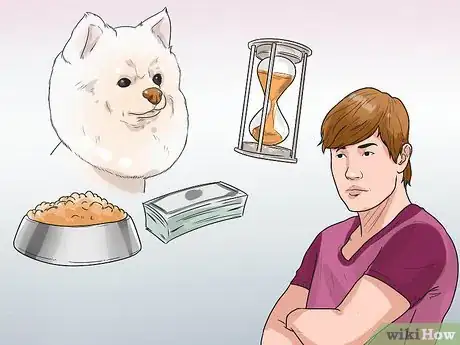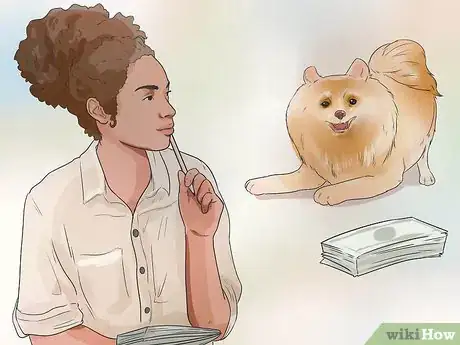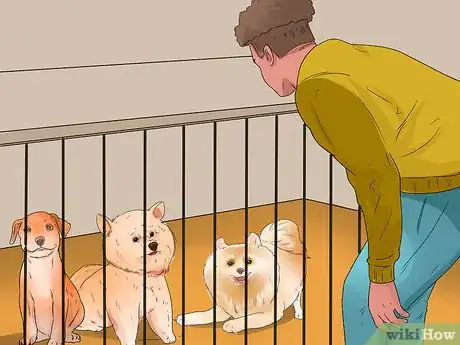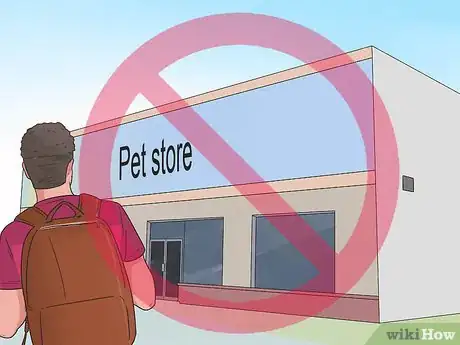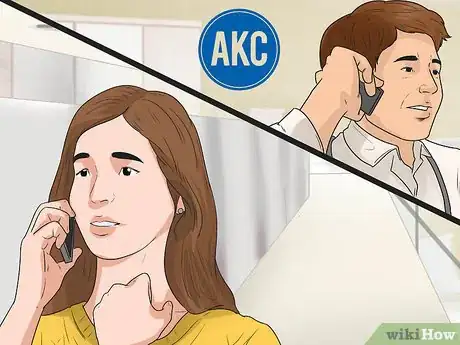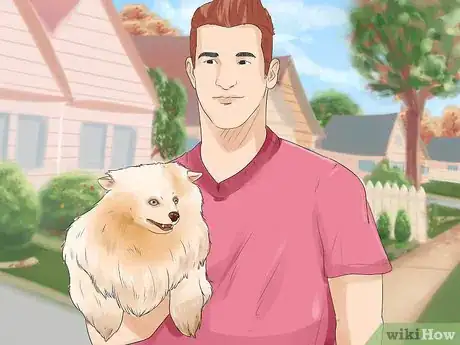This article was co-authored by Pippa Elliott, MRCVS. Dr. Elliott, BVMS, MRCVS is a veterinarian with over 30 years of experience in veterinary surgery and companion animal practice. She graduated from the University of Glasgow in 1987 with a degree in veterinary medicine and surgery. She has worked at the same animal clinic in her hometown for over 20 years.
There are 8 references cited in this article, which can be found at the bottom of the page.
wikiHow marks an article as reader-approved once it receives enough positive feedback. In this case, 93% of readers who voted found the article helpful, earning it our reader-approved status.
This article has been viewed 39,794 times.
Bringing a dog into your home is a long-term commitment. Depending on the dog, this can also be a potentially costly, yet worthwhile, investment. You might be thinking about a new dog for your home and are considering a Pomeranian. As a responsible pet owner, you need to do research on the Pomeranian breed, locate the best place to get the puppy, and determine how to properly care for your new friend before you decide to adopt your new family member. The more research you do beforehand, the better your experience will be with your new Pomeranian.
Steps
Considering your Lifestyle
-
1Evaluate your lifestyle. Any breed of dog that you adopt will require your time and energy, and although Pomeranians are small, they are no exception. It’s important to honestly evaluate your schedule to determine if you have enough free time to give your Pomeranian. Also, consider if your lifestyle is appropriate for this energetic, small breed.[1]
- Dogs need to be walked frequently or house trained to eliminate in a designated place.
- Pomeranians require frequent brushings or their hair will knot up.
- If you enjoy long hikes and imagine bringing your dog with you, for example, a larger breed may be more appropriate.
-
2Consider your family. Pomeranians are typically outgoing and energetic and can make a fantastic family pet. They require training, though, and cannot be expected to be a great family dog naturally. If you have small children and little time to train a puppy or someone in the home that won’t tolerate a Pomeranian’s high energy, you might do well to consider another breed.[2]
- This is a great time to ask your family what they imagine when they think about getting a dog. Do they imagine a large protector? Or perhaps a dog to which they can throw tennis balls? Maybe they envision a lap dog or one that they can dress up in fun costumes. Finding out what they expect can help you decide which breed is best for your family.
- Simply ask them, “Pomeranians are small and full of energy. They require a big investment of time, and we’ll need to work together on that. Do you think that your schedule will allow you time to brush, feed, walk, play with, and train the dog?”
- Also reassure them, “It’s good to be perfectly honest about what you want and think you can do for a dog. It’s better that we talk about it now and are as realistic as possible, rather than be surprised after we bring a dog into our home.”
Advertisement -
3Evaluate your finances. Purebred puppies are expensive, especially toy breeds like Pomeranians. This is not the only Pomeranian-related cost that you need to think about. Your dog will need proper care, such as regular veterinarian visits, shots, and preventative medicines for fleas, ticks, and heartworms. Your Pomeranian will also need good-quality food, dishes, a collar, tag, microchip, and toys. Additionally, you’ll need to budget for pet emergencies.[3]
- You may choose to groom your Pomeranian at home, which will cut some costs; however, you will need to purchase your supplies.
- You can also take your Pomeranian to a professional groomer. This is more expensive, but it saves you time.
- A good cost-cutting option is to purchase pet insurance, which may help pay for medications, vet visits, and emergencies.
Deciding Where to Buy Your Pomeranian
-
1Avoid puppy mills. Puppy mills are exactly what the name suggests – sites that generate quantities of puppies with little to no regard for quality of life or breed standard. Often parent dogs are kept in filthy, disease-ridden conditions and in failing health. Puppy mill puppies may be cute, but they usually have a list of health conditions that can be quite expensive for their new families. There are some red flags to look for that might indicate you’re dealing with a puppy mill.[4]
- Puppy mills almost always disguise themselves as a legitimate breeder or rescue organization, so it’s worth researching the location before you buy.
- Advertisements that appear regularly in the classified section or online.
- A breeder that won’t tell you their veterinarian’s information.
- A breeder or organization that always seems to have dogs available for purchase.
-
2Stay away from pet stores. Unless a pet store is offering dogs for adoption from a local animal shelter, it is almost guaranteed that they are selling puppy mill dogs. No business will admit to this, and you might even go to a pet store that tells you that they only use reputable breeders. This just isn’t the case. No breeder could keep up with the demand of a pet store, nor would a responsible breeder allow their puppies to be sold via a third party like a pet store.[5]
- If the pet store insists that they use reputable breeders, get the name and address and verify the information for yourself. Any reputable breeder will invite you for a site inspection.
-
3Distinguish between hobby and backyard breeders. Popular breeds, especially in the Toy class, such as Pomeranians, are pervasive in puppy mills and backyard breeders across the country. The name backyard breeder doesn’t mean that someone breeds dogs in their backyard. Instead, it means someone that breeds a large number of dogs or allows their dogs to breed carelessly. Hobby breeders, on the other hand, usually only have a couple of dogs that they monitor very closely, have genetically tested the dogs to ensure that they aren’t reproducing bad genes, and love the breed.
- Backyard breeders are typically not interested in making money, don’t fancy themselves breeders, and don’t have their dogs tested for genetic conditions. They usually don’t have much knowledge about breed standards or training.
- Hobby breeders are usually pretty passionate about the one breed that they work with and are careful about which animals they breed and take caution to not over-breed the animals. Hobby breeders are familiar with breed standards, training needs, medical needs, and will have the puppies properly vetted before sale.
-
4Contact a registered breeder. A good breeder will register with an organization, such as the American Kennel Club. They will also only breed the very best dogs, sometimes working with other breeders to bring two exemplary dogs together. A registered, reputable Pomeranian breeder will be happy to show you their facilities, allow you to meet their dogs, and walk you through why their dogs are worth breeding.
- Most breeders will also interview prospective buyers to ensure that the dogs will be placed in a forever home.
- Many Pomeranian breeders will require you to sign a contract at the time of purchase that stipulates everything from living conditions to rehoming.
- The AKC website has a list of registered Pomeranian breeders.[6]
-
5Rescue a Pomeranian. There are organizations around the world devoted to rescuing dogs, and some are specifically for Pomeranian rescues.[7] You’ll find a range of ages, sizes, and health conditions in rescues. Rescues are also passionate about their dogs, and will likely ask you to sign a contract and fill out a questionnaire about your living conditions. There are several advantages to adopting a Pomeranian from a rescue:
- They are usually housebroken.
- The rescue will tell you how the dog interacts with dogs, cats, and children.
- You will know any medical conditions up front.
- The adoption fee is significantly less than purchasing from a breeder.
- You can adopt an older dog, who may be trained, if you don’t want to endure the “puppy” phase.
Getting to Know the Breed
-
1Research Pomeranians. Familiarize yourself with the Pomeranian breed so that you can confidently decide whether this is the breed for you or not. Read books and conduct Internet research about the Pomeranian breed so you know how to properly care for them and know common personality traits and possible quirks.[8]
- Pomeranians are a toy breed, meaning they are quite small, ranging from 3-7 pounds.
- They are very energetic, seeming to have a limitless supply of energy.
- They tend to get along well with other dogs and people.
- They are incredibly alert and attentive.
- They may bark a lot, especially if they hear an unfamiliar sound or see an unfamiliar person.
-
2Maintain reasonable expectations. In your research, you’ll also learn exactly what a Pomeranian is not. You may have expectations of your future dog, and it’s good to find out if a typical Pomeranian will fit the bill. Remember, though, that each dog has its own unique personality and can defy the rules.[9]
- Pomeranians are not work dogs and tend to be relatively fragile.
- Low maintenance – Pomeranians require regular bathing and brushing.
- Quiet – Pomeranians tend to bark frequently at unfamiliar people, dogs, or other animals outside the family circle. If everyday barking bothers you, a Pomeranian is probably not the dog for you.
- Easy to house train – smaller dogs are typically more difficult to house train than their larger counterparts.
-
3Learn the breed standards. The American Kennel Club has established the breed standard for Pomeranians and other purebred canines, and have made that information available on their website.[10] It’s good to be familiar with breed standards so that you know what to look for when you’re shopping for a Pomeranian, and also so that you can spot any issues that emerge as your dog matures.
- The Pomeranian has a dense, double coat and a heavily-plumed tail.
- The dog will have a short muzzle and dark, round eyes.
- The upper and lower length of the legs should be approximately equal.
- The dog will have a black nose with natural browning.
Warnings
- If you already have other dogs, particularly dogs of larger breeds, the new dog will need to be socialized with the existing dogs to ensure a smooth transition. Larger dogs could potentially harm a Pomeranian if rough play is allowed. Monitor all playtime activities between the new Pomeranian and larger dogs.⧼thumbs_response⧽
- Pomeranians are prone to broken bones, hypothyroidism, collapsing trachea, and luxating patellas.⧼thumbs_response⧽
- Do not buy Pomeranians from pet shops, puppy mills, or informal backyard breeders who are not registered with a kennel club. Patronizing any of these establishments further encourages puppy farming, which is likely to be the cause of serious health and behavioral problems of their puppies in the years to come. Only buy from reputable Pomeranian breeders who dedicate time and effort to all of their dogs.⧼thumbs_response⧽
References
- ↑ http://www.akc.org/dog-owners/future-dog-owner/about-buying-a-dog/
- ↑ http://www.akc.org/dog-breeds/pomeranian/detail/
- ↑ http://www.akc.org/dog-owners/future-dog-owner/about-buying-a-dog/
- ↑ http://www.petful.com/animal-welfare/puppy-mill-red-flags/
- ↑ http://www.humanesociety.org/issues/puppy_mills/tips/buying_puppy.html?credit=fb_post2015
- ↑ https://www.apps.akc.org/apps/breederinfo/breeder_search.cfm
- ↑ http://pomeranian.rescueme.org/
- ↑ http://www.yourpurebredpuppy.com/reviews/pomeranians.html
- ↑ http://www.yourpurebredpuppy.com/reviews/pomeranians.html
About This Article
To buy a Pomeranian, you should look for a reputable breeder that's registered with the American Kennel Club. Or, you can search for reputable Pomeranian rescues online, which have cheaper adoption fees. Never buy a Pomeranian from a pet store, through an online ad, or from a breeder who isn't registered since their dogs most likely come from puppy mills. For more advice from our Veterinary co-author, like how to tell if a Pomeranian is the right dog for you, read on!
